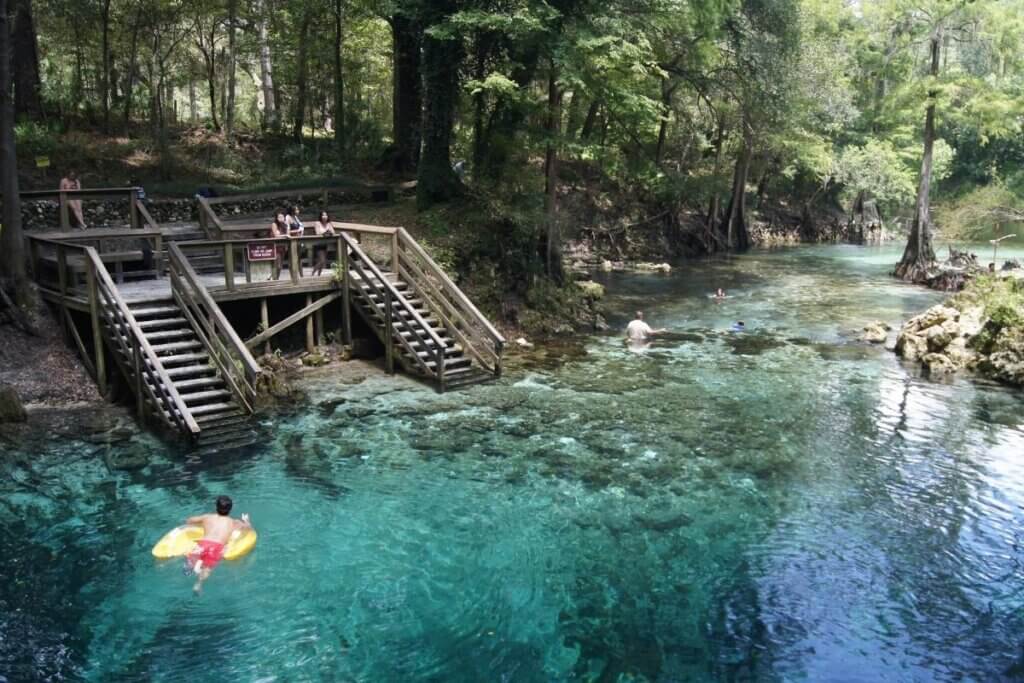Last Updated on September 27, 2022
For years our followers have told us about Blue Spring State Park. Finally, our team loaded up, and we set off to explore one of Florida’s most delightful state treasures. Located north of Orlando and west of Orange City, Central Florida’s Blue Spring State Park covers 2,600-acres of “real” Florida. For all-around family fun, it’s hard to beat the authentic beauty, enjoy the opportunity to see wintering manatees while learning some fascinating Florida history.

What is Blue Springs State Park?
The Blue Spring State Park is a designated manatee refuge and from November to March, it’s ideal for viewing the creatures wintering there. The refreshing, 72-degree water of Blue Spring is welcome warmth for the West Indian Manatee requiring respite from the cooler St. Johns River. Later in the year, as the weather and water temperature warms, the swimming area is opened to people as the resident manatees migrate upriver.
A half-mile boardwalk borders the Blue Spring Run, the main manatee viewing area, with the translucent spring on one end and the St. Johns River on the other. Interpretive displays along the boardwalk provide history and education about the wildlife (particularly manatees) and the ecological wonders of the area. The park offers St. Johns River Cruises, narrated by knowledgeable guides regarding the local ecology and wildlife. Or if you prefer to go on your own, canoe and kayaks are available for rent. Guided tours are also available. Nearby picnic areas and tables are plentiful. More than 50 campsites and six cabins are available.
What is the history of Blue Springs State Park?
For hundreds of years, the indigenous Timucuans made the first-magnitude Blue Spring and surroundings their home. At the time, manatees were very plentiful and important for the Timucuan diet. By the mid-1800s, the remaining tribal members were forced to leave their homes, heading south. The Timucuans left behind shell middens, or mounds, which have given historians a glimpse into their culture and past. Later, pioneer settlers moved in and in 1872, including the Thursby family who made their home on top of one of the Tumucuan middens, after purchasing the Blue Spring area. The Thursby’s became orange growers, earning a living by shipping fruit up the St. John’s River. The family eventually developed a popular resort and became hosts to tourists traveling aboard the visiting steamboats.

See manatees and more at Blue Springs State Park
The Blue Spring is popular with swimmers and scuba divers, especially for the extensive underwater cave system. There’s fishing too, with plenty of very large gar, bass, and more.
Perhaps our favorite part of the park was the panoramic view from the boardwalk. Picturesque “old Florida” moss-draped oaks line the blue-green river, with fallen trees along the banks – ideal elements for composing prize-winning photography. That said, it’s also easy to photograph and video the manatees as they congregate in the main viewing area and surface every so often for air. Manatees are gentle, extraordinary creatures and if you have never seen one or wish to enjoy them again, we highly recommend this adventure.
About Manatees
The Blue Spring Park was actually acquired by the Florida Department of Environmental Protection to begin its Manatee Protection Program. Here are some interesting facts about Florida’s delightful creatures:
- Manatees are gentle, slow moving creatures usually found in warmer, temperate waters
- Manatees are related to the elephant and are grayish brown with thick wrinkled skin
- There are estimated to be around 6,000 manatees in Florida
- They are mainly herbivores, eating marine and freshwater plants
- Manatees weigh anywhere between 1,500-1,800 lbs.
- They have an average lifespan of 50-60 years in the wild
- Manatees breathe through their nostrils
- They bear one offspring per year; calves typically weigh 60-70 lbs. and nurse underwater
- Manatees possess powerful flat tails that help them propel in the water
- Manatees are a threatened species
- The greatest threats to manatees are: the destruction of their coastal and freshwater habitat, careless boaters, boat propellers, and global climate change affecting water quality and temperature

